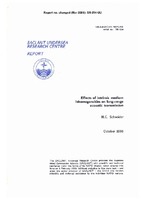| dc.contributor.author | Schneider, Hans G. | |
| dc.date.accessioned | 2018-10-11T14:06:48Z | |
| dc.date.available | 2018-10-11T14:06:48Z | |
| dc.date.issued | 1993/10 | |
| dc.identifier | 1994 | |
| dc.identifier.govdoc | SR-214 | |
| dc.identifier.uri | http://hdl.handle.net/20.500.12489/300 | |
| dc.description.abstract | Duda et al. [J. Acoust. Soc. Am. 92(2), 939-955, 1992] have measured wavefront arrival times over a | |
| dc.description.abstract | 1000 km track in the Pacific. In modelling the propagation they use a WKBJ-based approch in the raytheory | |
| dc.description.abstract | limit which cannot explain the vertical extension of the measured arrival structure into the | |
| dc.description.abstract | shadow zone, i.e. into depths greater than the ray-theoretical turning point depth. A possible | |
| dc.description.abstract | explanation of this effect is presented here by assuming an intrinsic stochastic variability of the sound speed which is too small to disturb the main ray paths but sufficiently large to deviate energy into the shadow zone. This assumption is substantiated by a generic model based on stochastic ray tracing. The effects modelled are of the correct order of magnitude but more exact evaluations cannot be made because of missing oceanographic information. However, this type of experimental result could be used to estimate the missing oceanographic quantities if a more detailed methodology were | |
| dc.description.abstract | developed. | |
| dc.format | 15 p. : ill. ; 6 fig. | |
| dc.language | English | |
| dc.publisher | NATO. SACLANTCEN | |
| dc.relation.ispartofseries | ADB182897 | |
| dc.subject | Acoustic propagation | |
| dc.subject | Ray tracing | |
| dc.subject | Acoustic models | |
| dc.title | Effects of intrinsic medium inhomogeneities on long-range acoustic transmission | |
| dc.type | Scientific Report (SR) | |
